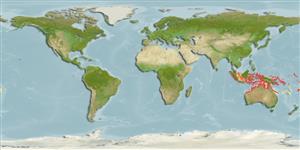>
Syngnathiformes (Pipefishes and seahorses) >
Syngnathidae (Pipefishes and seahorses) > Syngnathinae
Etymology: Hippocampus: Greek, ippos = horse + Greek,kampe = curvature (Ref. 45335).
More on author: Whitley.
Environment: milieu / climate zone / depth range / distribution range
Ekologi
marina revassocierade; ej vandrande; djupintervall 0 - 40 m (Ref. 30915). Tropical; 3°N - 23°S
Indo-West Pacific: Indonesia and eastward to Vanuatu; north to Japan; south to Australia.
Length at first maturity / Size / Vikt / Age
Maturity: Lm 1.3 range ? - ? cm
Max length : 2.4 cm OT hane/ej könsbestämd; (Ref. 31803)
Short description
Morfologi | Morfometri
Taggstrålar i ryggfenan (totalt): 0; Mjukstrålar i ryggfenan (totalt): 13-15. Description based on 4 specimens: Adult height, less than 2.0 cm. Rings, 11-12 + 31-34. Snout length is greater than 4.0 in head length. Dorsal fin rays, 13-15 covering 1+1 rings. Pectoral fin rays, 10. Coronet, a rounded knob. Spine, as irregular bulbous tubercles scattered over body and tail; a single prominent rounded eye spine; a single low rounded cheek spine. Other distinctive characters: head and body very fleshy, mostly without recognizable body rings; ventral portion of trunk segments incomplete; snout extremely short. Color pattern: two color morphs are known: (a) pale grey or purple with pink or red tubercles (found on gorgonian coral Muricella plectana) and (b) yellow with orange tubercles (found on gorgonian coral Muricella paraplectana).
Only known to occur on gorgonian corals of the genus Muricella, with up to 28 pairs on a single gorgonian. The tubercles and truncated snout of this species match the color and shape of the polyps of the host gorgonian, while its body matches the gorgonian stem. So extreme is this camouflage that the original specimens were only noticed after their host gorgonian had been collected and observed in an aquarium. Post-pelagic young settle on various hosts, but to breed, they appear to prefer the red polyp Muricella spp. That usually grow in depths over 20 m (Ref. 48635). Ovoviviparous (Ref. 205). The male carries the eggs in a brood pouch which is found under the tail (Ref. 205). Minimum depth reported taken from Ref. 128812.
Possibly monogamous in the wild (Ref. 30915). Male carries the eggs in a brood pouch (Ref. 205).
Lourie, S.A., R.A. Pollom and S.J. Foster, 2016. A global revision of the seahorses Hippocampus Rafinesque 1810 (Actinopterygii: Syngnathiformes): taxonomy and biogeography with recommendations for further research. Zootaxa 4146(1):1-66. (Ref. 115213)
IUCN Red List Status (Ref. 130435)
Threat to humans
Harmless
Human uses
Fiskeri: saknar intresse
Ytterligare information
Age/SizeTillväxtLength-weightLength-lengthLength-frequenciesMorfometriMorfologiLarverLarvdynamikRekryteringAbundansBRUVS
referenserVattenbrukVattenbruksprofilAvelslinjerGenetikElectrophoresesÄrftlighetSjukdomarBehandlingNutrientsMass conversion
MedarbetareBilderStamps, Coins Misc.LjudCiguateraHastighetSimsättGälytaOtolithsHjärnstorlekSyn
Verktyg
Special reports
Download XML
Internet-källor
Estimates based on models
Preferred temperature (Ref.
123201): 25.9 - 29, mean 27.7 °C (based on 134 cells).
Phylogenetic diversity index (Ref.
82804): PD
50 = 0.5000 [Uniqueness, from 0.5 = low to 2.0 = high].
Bayesian length-weight: a=0.00447 (0.00177 - 0.01127), b=3.00 (2.78 - 3.22), in cm total length, based on LWR estimates for this (Sub)family-body shape (Ref.
93245).
Trofisk nivå (Ref.
69278): 3.4 ±0.5 se; based on size and trophs of closest relatives
Resiliens (Ref.
120179): Hög, lägsta populationsfördubblingstid mindre än 15 månader (Fec=34).
Fishing Vulnerability (Ref.
59153): Low vulnerability (10 of 100).
Nutrients (Ref.
124155): Calcium = 294 [140, 691] mg/100g; Iron = 1.19 [0.60, 2.32] mg/100g; Protein = 17.3 [15.9, 18.7] %; Omega3 = 0.152 [0.070, 0.328] g/100g; Selenium = 23.8 [8.4, 66.7] μg/100g; VitaminA = 262 [68, 983] μg/100g; Zinc = 3.31 [1.96, 5.17] mg/100g (wet weight);
